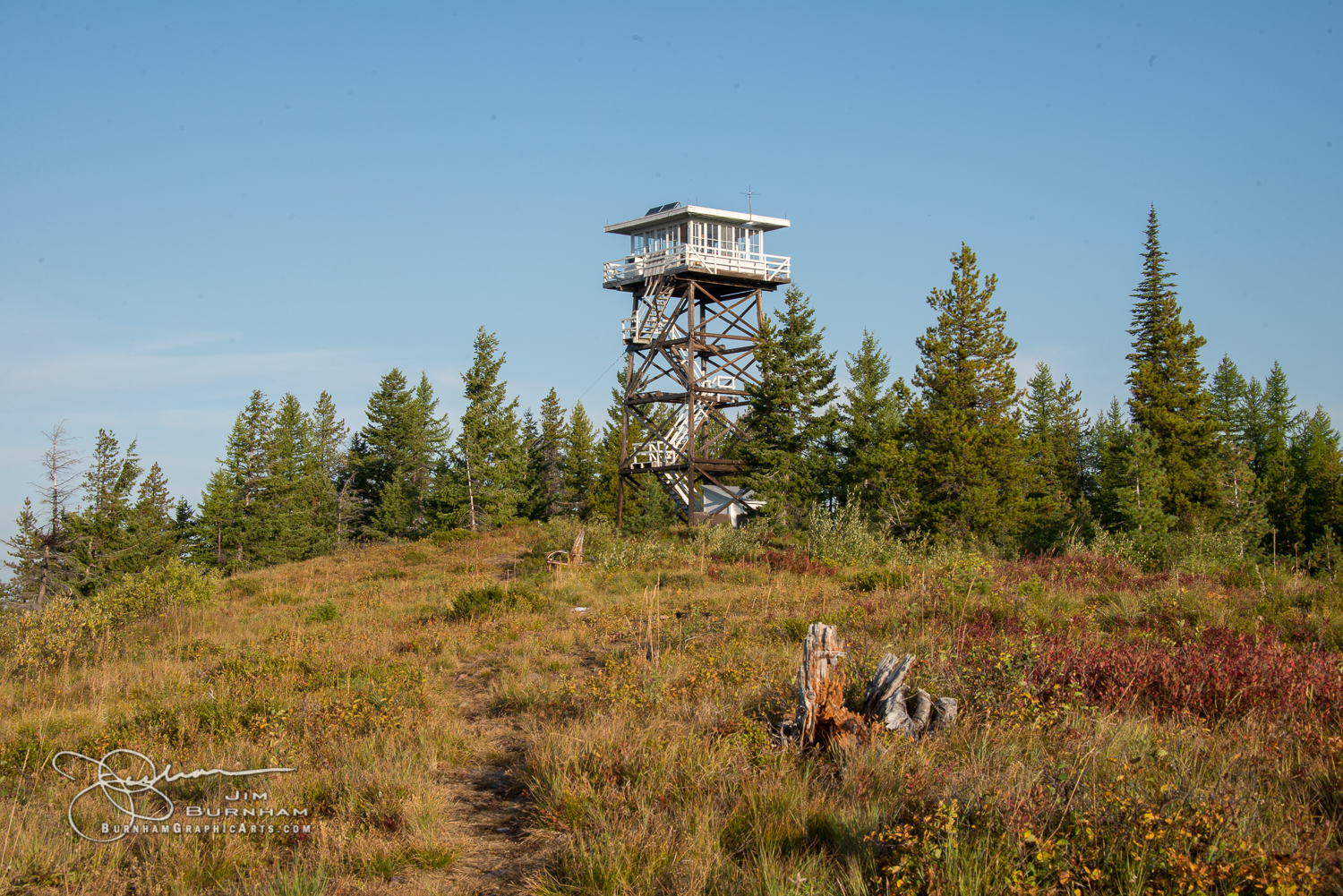
Firetower on North side of Hungry Horse Reservoir
“Everyone wants to live on top of the mountain, but all the happiness and growth occurs while you’re climbing it.”
— Andy Rooney
Another adventure with Jim Caldwell (The Fotobug), this time in the wilds of Glacier National Park in Montana. Another location off my bucket list, and another location sure to be visited again. Places like this are never fully explored in a week, a month, even in a lifetime. Every vantage point is at the very least a beautiful memory. At best, maybe hanging on someone’s wall. This is part travelogue, musings on nature, and history lesson.

My name is Jim Burnham. I am a US photographer. Follow me on Instagram or Twitter -> @BurnhamArts
Triple D Wildlife
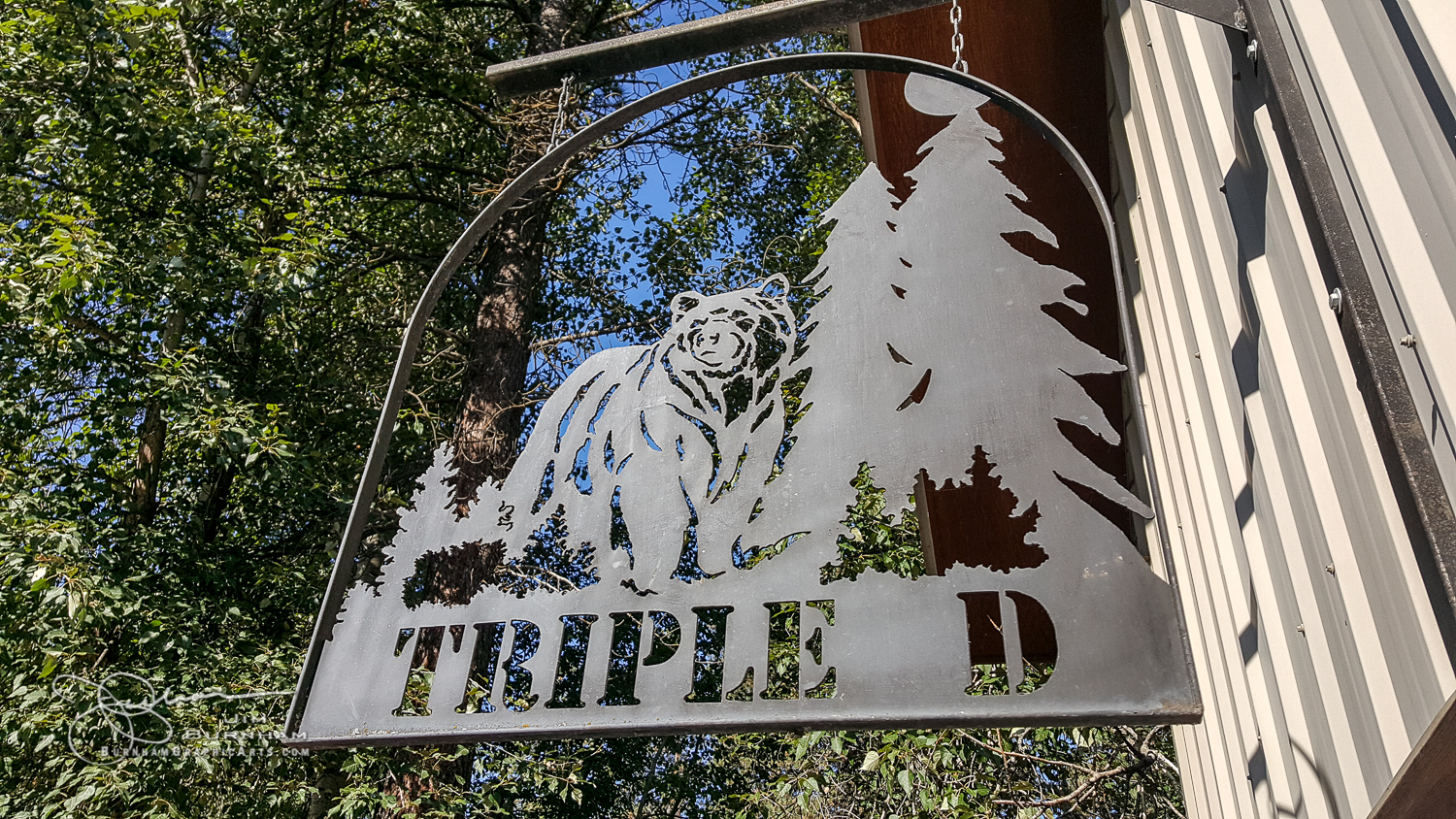 Many of us wish we could take a week and track wild animals in their native habitat. The thrill of finding them and getting close enough to get a stunning shot must be exhilarating at the least. There are a handful of adventure photographers who can do this and my hat is off to them! But there are different levels of wildlife photography, each of us falls into one or more of these levels, based on convenience, motivation, and access to that ever elusive part of life: free time.
Many of us wish we could take a week and track wild animals in their native habitat. The thrill of finding them and getting close enough to get a stunning shot must be exhilarating at the least. There are a handful of adventure photographers who can do this and my hat is off to them! But there are different levels of wildlife photography, each of us falls into one or more of these levels, based on convenience, motivation, and access to that ever elusive part of life: free time.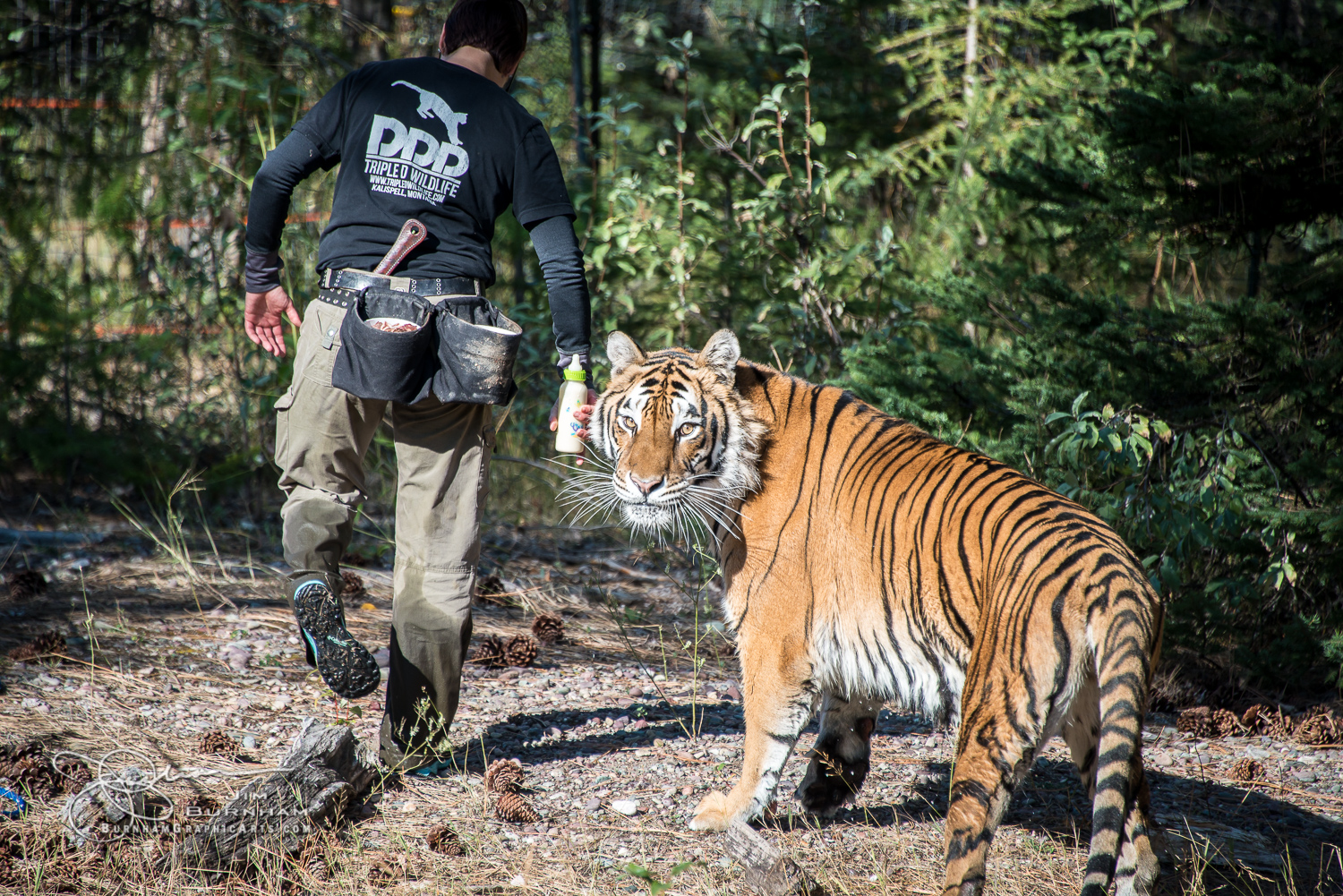
Zoo photography falls into the “captive and convenient” category. Zoos are great practice for the wild world, but only in technique, really. You aren’t doing any work finding them. Also, zoos have very little to offer in the way of a scenic location. You might be shooting through a fence, a glass window, or have fake rocks in your shot. This shot I took of the wolves and lynx at Brookfield Zoo many years ago was right through wire fences. The wires were rendered out of focus by getting close to the fence and zooming in with a wide aperture, but the lines still created some patterns and shadows, which I attempted to reduce in post. I still like these photos, but they “zoo” shots and took way too much work to make look “natural”.
A compromise and a step above this are the private enterprises that provide wild animals to photographers. For a fee, you can have access to one type (like Wolf Park in Battleground, IN which handles wolf rehabilitation and return) or a wide variety of animals like Triple D in Kalispell, MT. Triple D is run by Jay and Kim Deist, who employ up to 7 full-time handlers to care for and train the animals in their park. Although many enterprises like this are considered unethical, the demand is still very high. See the Audubon article that mentions many poorly run enterprises and does mention Triple D, but Triple D is essentially an exception to those. In short, you might oppose any type of business that provides wildlife that is not 100% wild, but if you want a highly regarded game park that cares deeply for the animals in its care, this is one to look at. If you want to know more, visit https://tripledwildlife.com/landing/about-us/
They have 19 different types of animals and over 160 individual animals on their property. We could have two animals for each session and for our two sessions, our choices were: Tundra Wolf and Siberian Tiger for day 1, and a Lynx and Mountain Lion for day 2. To be clear, I would never claim any photo I took here was “in the wild”, or submit it to a magazine without disclosing the source. Most magazines will not accept game farm animals, but that does not stop unscrupulous photographers from submitting them as natural. If you object to captive animals being used for commercial enterprise, skip to Lake McDonald below. But from what I saw, this team was honest and caring about their animals. I saw only love in both directions.
This is the first trip where I was handling two cameras at the same time. If you read the account of the Alternate Black Hills Photo Shootout last year, I had left my D7100 on the plane in Chicago and didn’t get it back for a few weeks. In the meantime, my friends Doug and Eileen Leunig loaned me their idle D800E (which is eventually bought from them). I had a 28-300mm lens on the D800 and my 150-500mm Sigma on the D7100 for super close-ups. Heavy load, but very convenient. The only problem was that one camera had a timestamp an hour behind and the naming format was different, so putting the photos in order later was a little confusing. Always remember if you are working two cameras, make sure the date/time is coordinated.


The catchlight in the eyes is a good indicator of a focused shot. If it is elongated, that means there was motion blur, which I had in a good portion of my shots.
On a trip like this, I usually take about 1,100-1,400 photos. That sounds like a lot, but Mike Wolforth told me he easily shoots 4,000 mostly because he has his camera set to take several shots all in sequence, each bracketed at different exposures. Even though I had two cameras, I ended up taking almost as many with one as the other, all in total over 3,500 photos. I never thought I would be the “two camera” guy, but it did come in handy not having to switch lenses and gear every time I wanted a different type of shot. Also, when shooting animals, I want that “feel” that only comes with a stare, or the face or body pointed a certain way. If I needed a close-up shot, all I had to do was switch cameras, no fumbling with switching lenses.
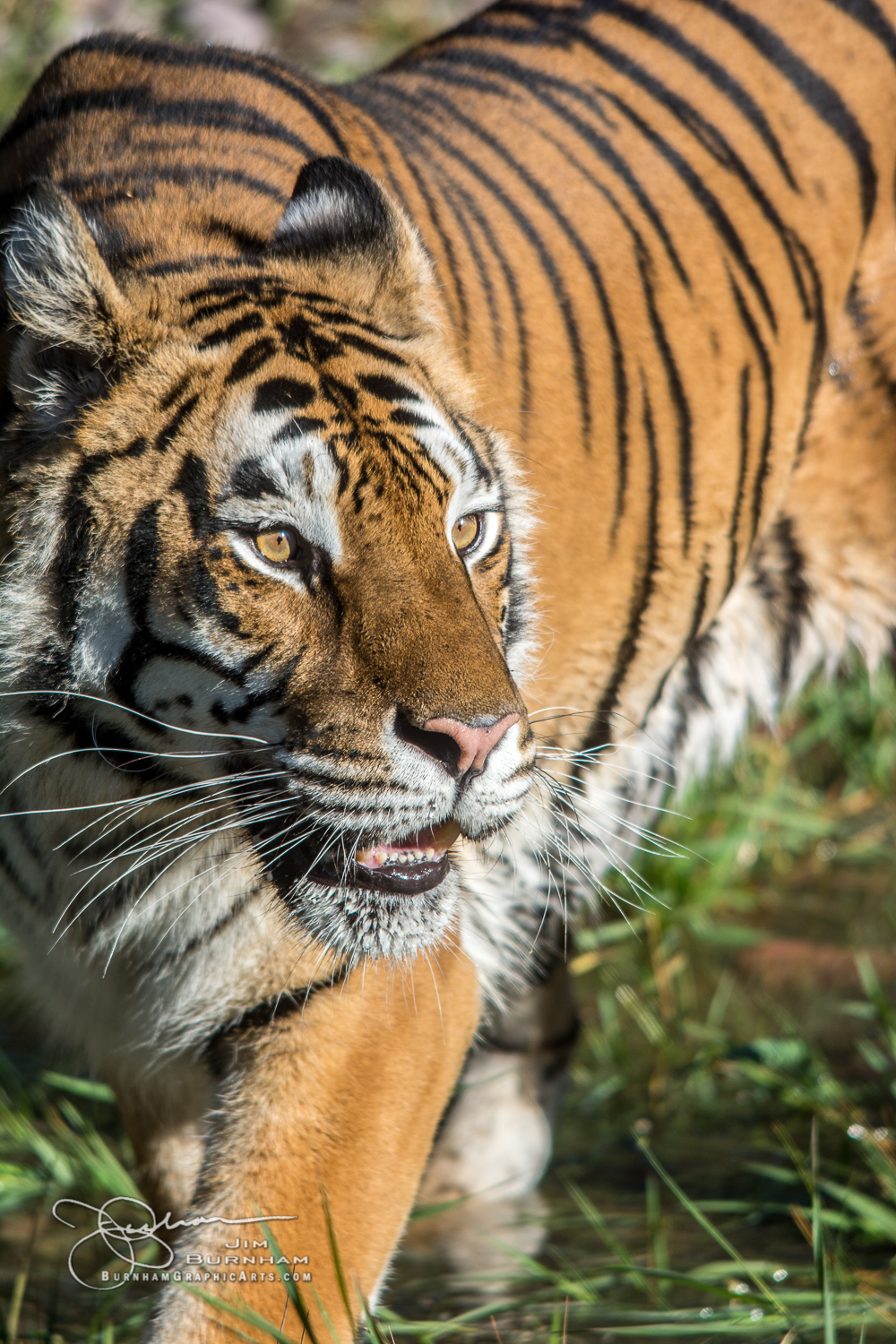
You take a lot of shots to get that “feeling”. I’ve always felt that good photographers should only share what stirs their soul. Out of a 1,000 photos, I’d be happy if 100 were good and 10 were worthy of printing. Out of the 3,500 shots from the whole week, I was happy with 300. Out of that, about 25% might end up being worthy and offered as a print. That aligns with the 1% bar I set for myself. I might share half of that. I don’t share everything that is good. I try to share only the things that move me emotionally.
Glacier National Park – Lake McDonald
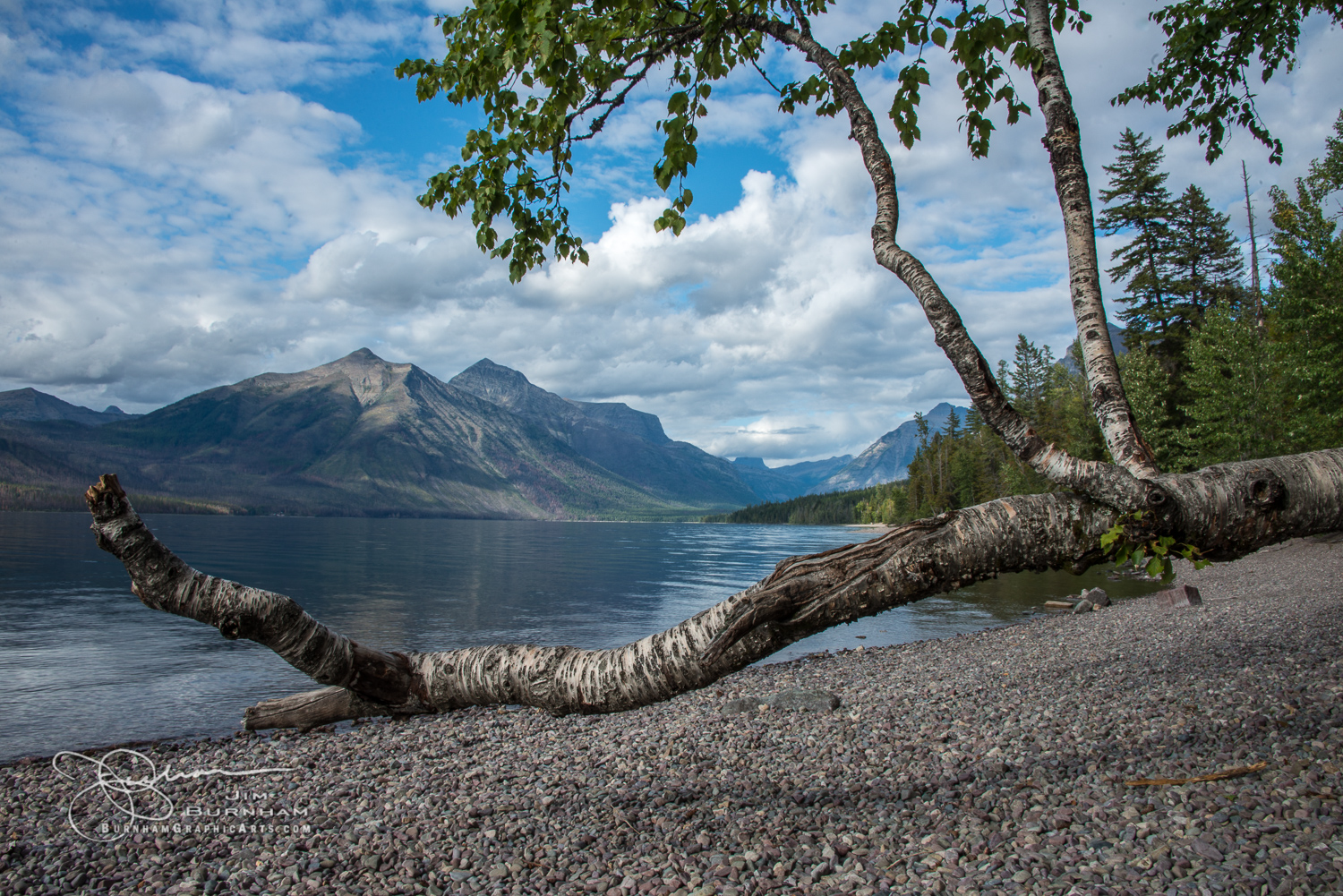
Glacier National Park is this country’s 10th national park, created by President Taft in 1910. The Great Northern Railway brought more people to what was originally an area only populated by native Blackfeet, Salish and Kootenai tribes. I’d be remiss not to recognize the first people’s contribution and eventual sacrifice under the auspices of “nation building”. Today, there are seven federally recognized tribes in Montana: Blackfoot, Kootenai and Salish, Crow, Chippewa, Assiniboine and Gros Ventre, Sioux and Cheyenne. To learn more, visit: https://montanatribes.org/
With the advent of the automobile around the same time, there were calls for easier access. The first major route through the park was dedicated in 1933 and was named “Going to the Sun Rd” as both East and West routes take you to Logan Pass, the highest point you can get to by car. The first feature you see on the West side is Lake McDonald.
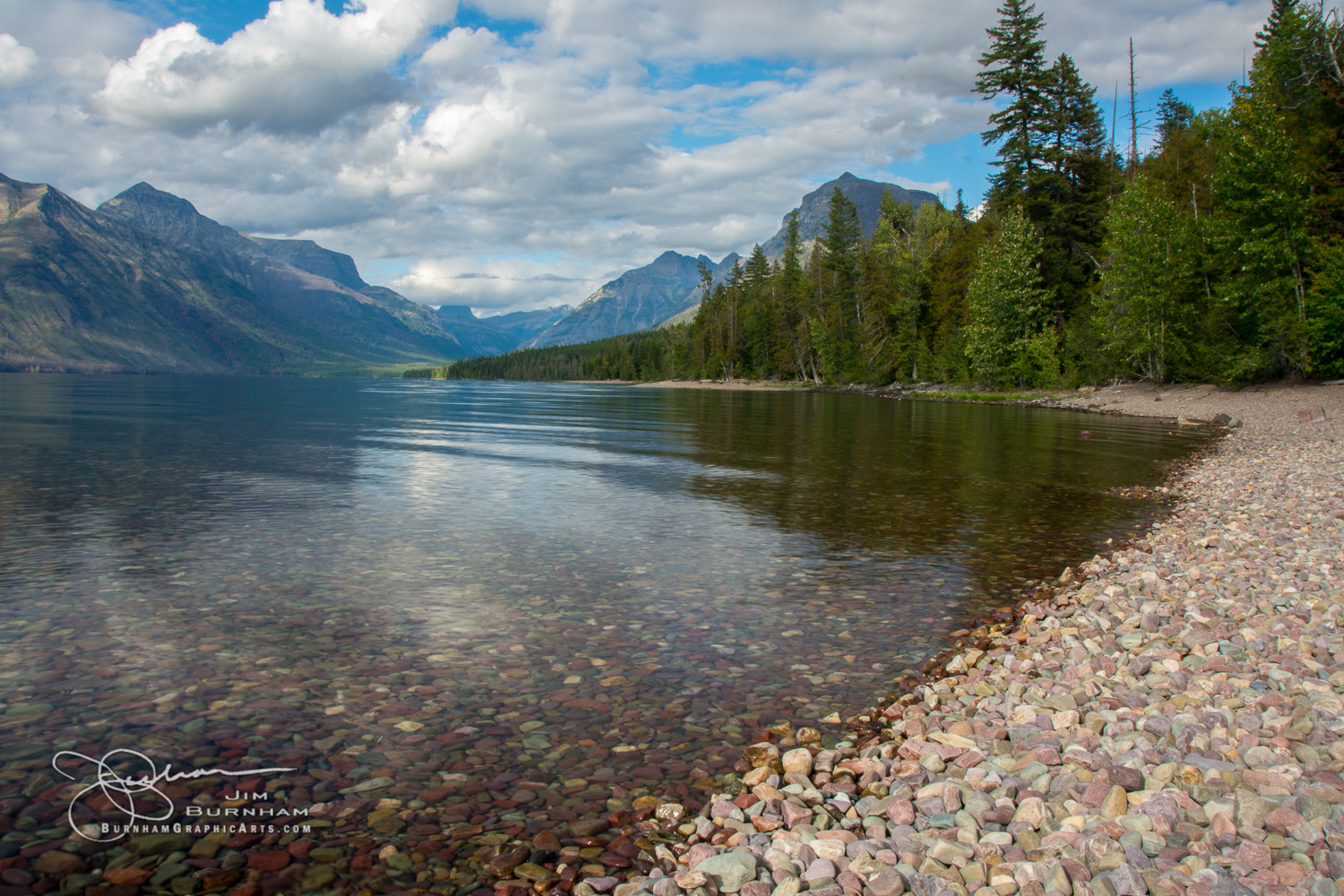
There is one particularly stunning feature about Lake McDonald at the West Glacier entrance to Glacier National Park. The shore is made up entirely of 1-2″ round rocks of all different colors and patterns. Occasionally strewn about are larger, more craggy rocks, but when you peer into the shallow water, the colors are stunning and varied blues, greens, reds, browns, and oranges. I’ve grown up on Lake Michigan, where there are stretches of rocky shore, but the sizes and shapes are varied and mostly gray or mottled granite. These are more like a jar of gumballs.
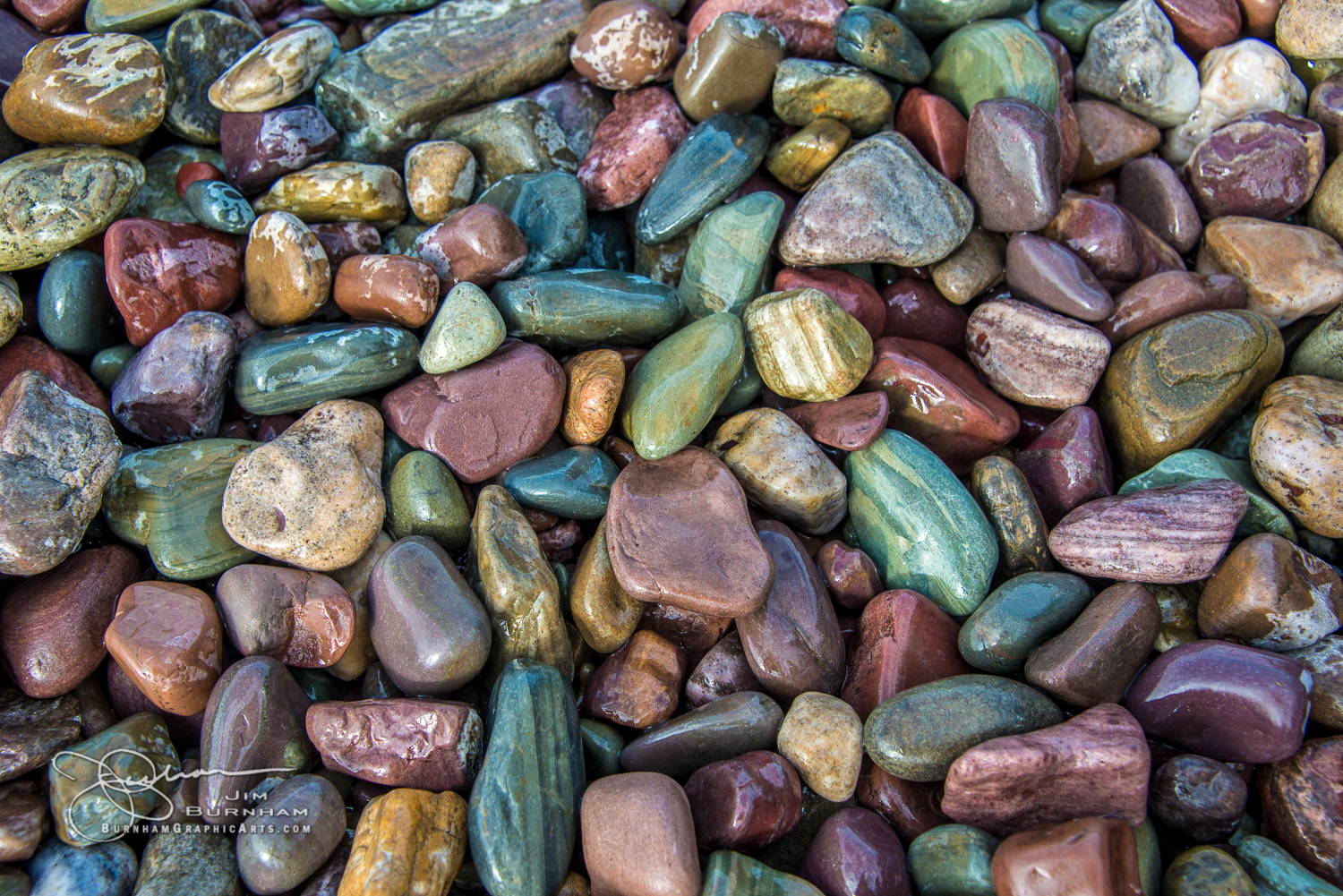
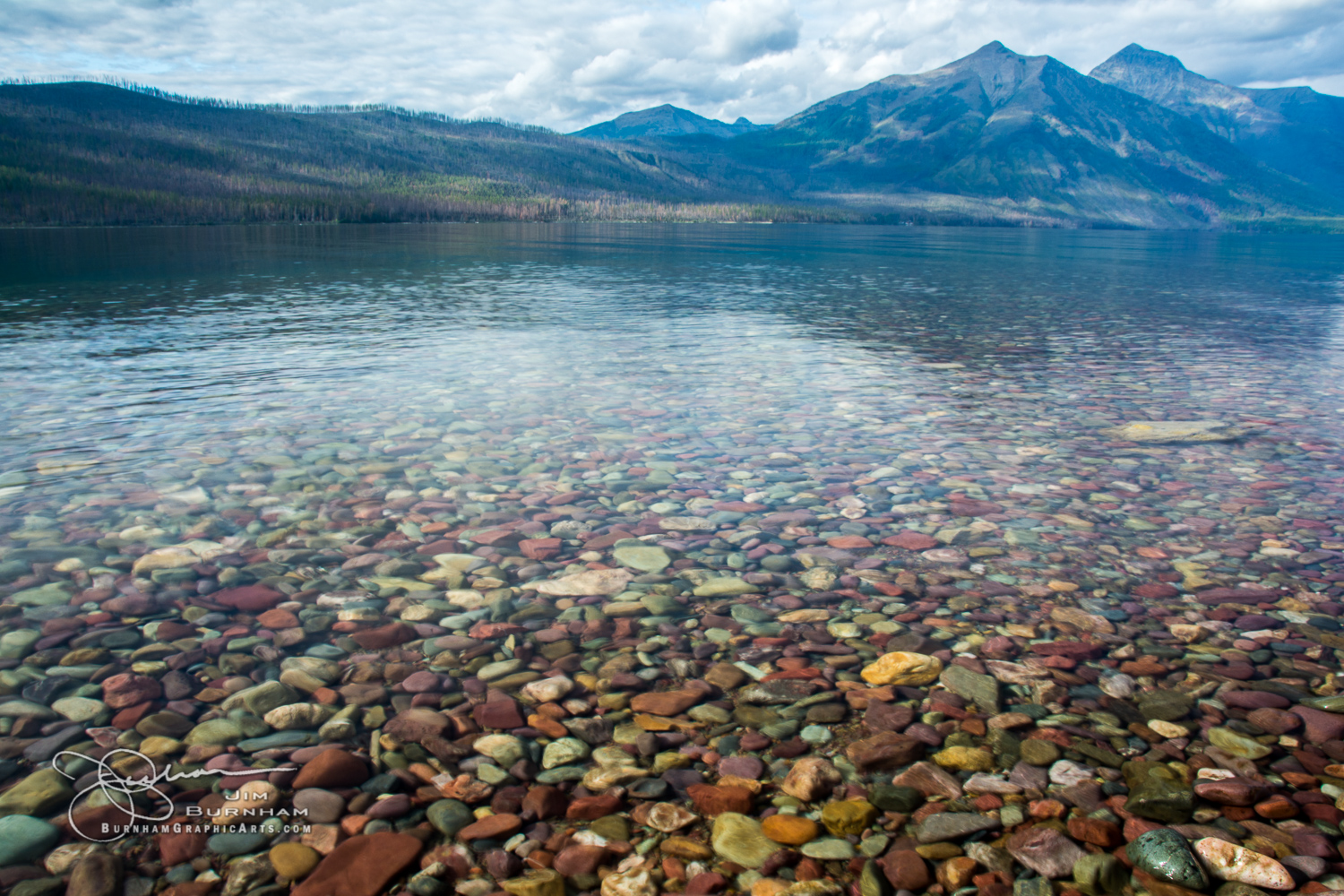
Feeding into Lake McDonald are numerous streams, rapids, and waterfalls that run down from the mountains from the North West. For the rapids, I like a long exposure and as much focus from front to back as possible, so using a small aperture (f22) in addition to a neutral density filter (5 stop) allows me to run the shutter speed up to 1-2 seconds, rendering the water to a silky smooth flow.
F22 combined with the widest zoom level (18mm) puts everything from 1 meter forward in sharp focus. I don’t have to worry about focus, I just set it at 1 meter and on manual. In this way, I can simply move the camera where I want and only play around with shutter speed (and remove or install the neutral density filter) to get what I want.
Going to the Sun Road
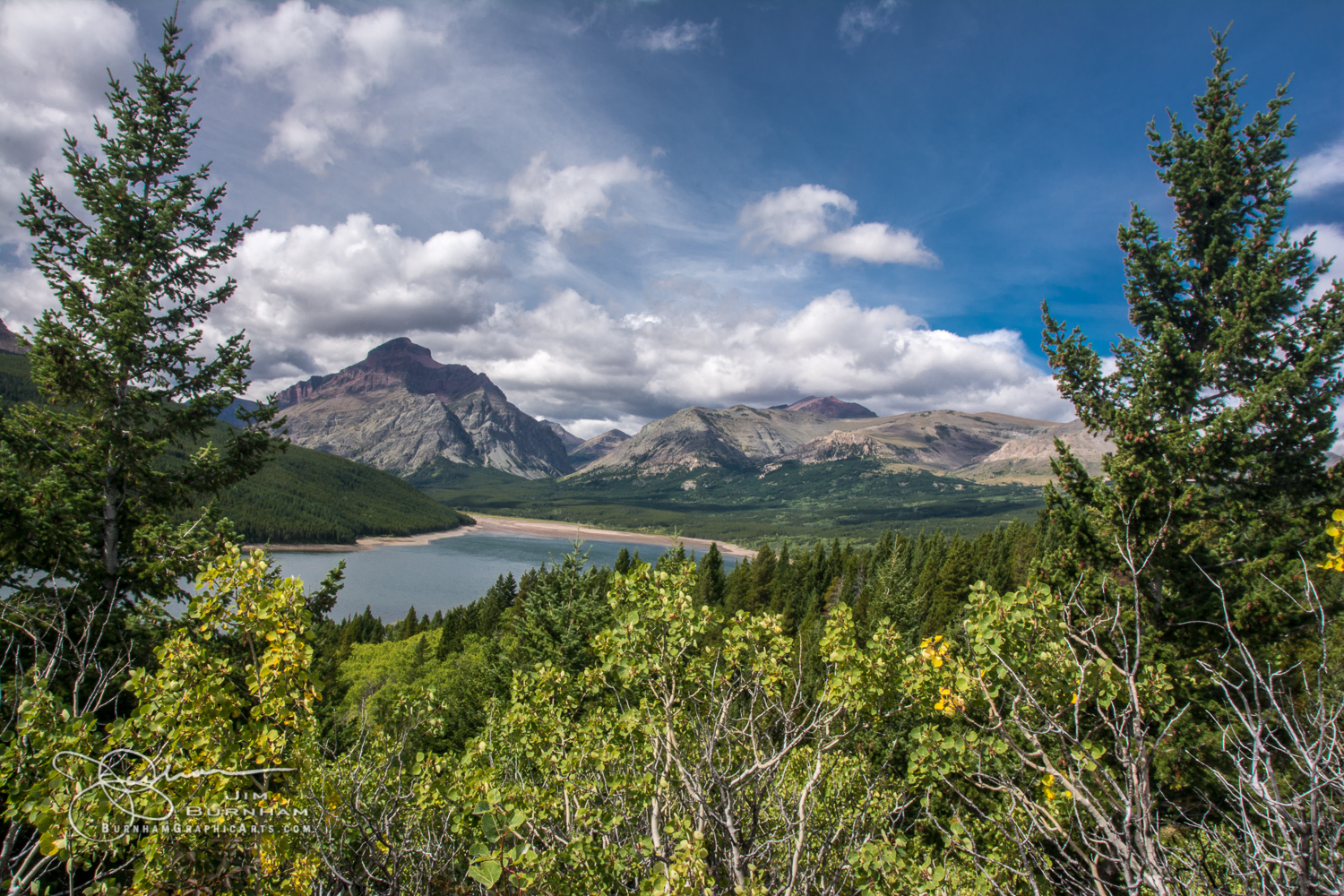
Two Medicine Lake on the Eastern boundary of Glacier National Park
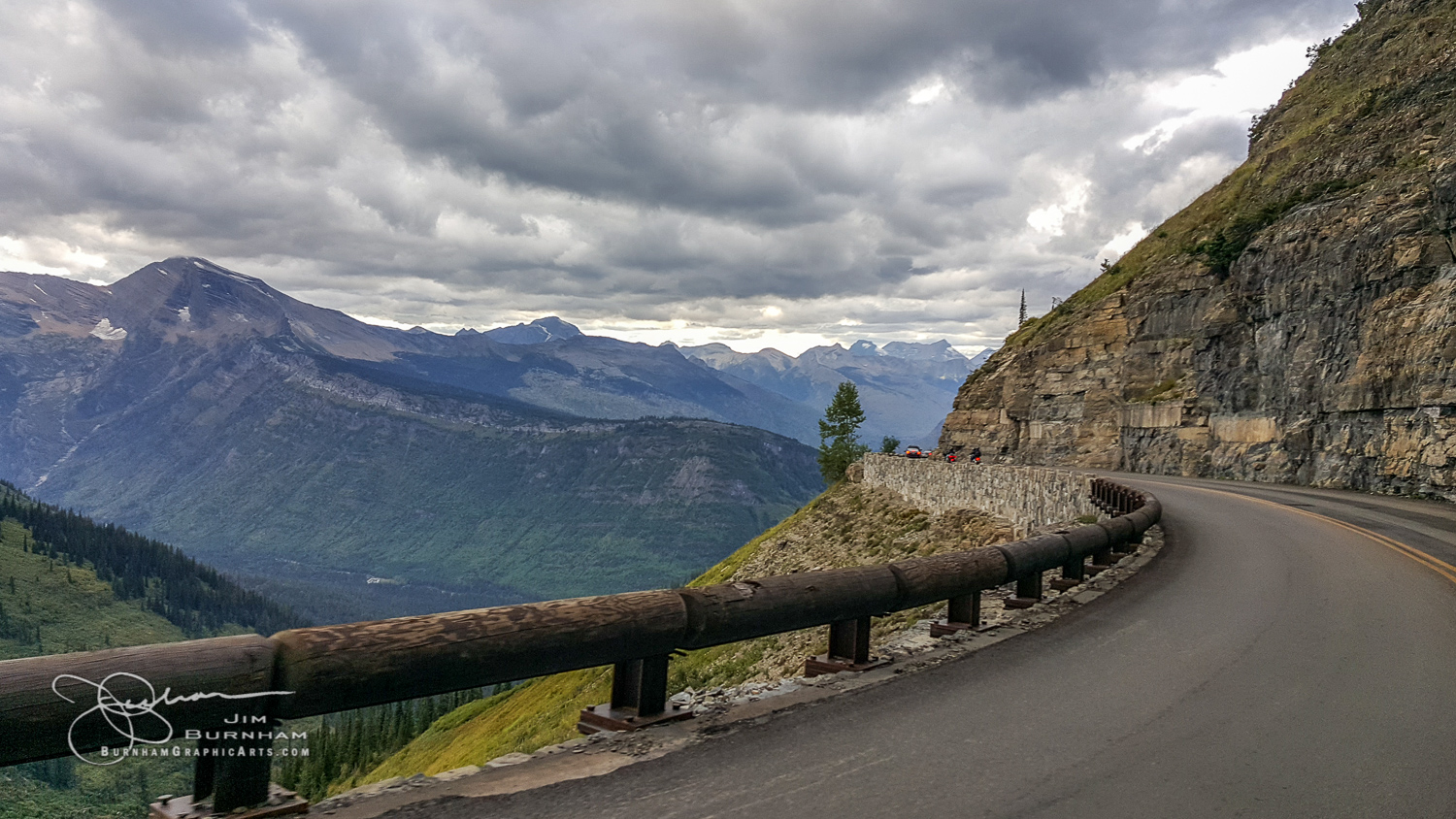
Going to the Sun Road with it’s iconic log railings dating back to the original creation of the road in the 1920s

Whitebark Pine on Going to Sun Road, Glacier National Park
The road that encircles Glacier National Park provides breathtaking views from the lowest valleys to the highest passes (Logan Pass). All drivable and peppered with pull-offs and trail-heads. On day 1, we ran up the West side along Lake McDonald. On Day 2, we drove up farther up the West side up to Logan Pass to the North. One Day 3, we completed the whole loop around from West to East Glacier, to St Mary’s Lake, up to Logan Pass and then down the West side.
On the way along St Mary’s Lake, I saw out of the corner of my eye what I thought was the shape of a bear. After turning around and backtracking, we did not see the same shape in the same place. At one point, while the group went back to the restaurant to retrieve a coat, I stayed back and took a timelapse of the clouds. They returned with fabulous stories of having seen the bear, but could not get their cameras out fast enough to get a shot of it. Right, three people with 5 cameras collectively could not get an image? I believed it, though, for a minute, maybe two. 😉
However, not too far up the road, there were several people focused on one side of the mountain to the North where a hungry Grizzly Bear was foraging lazily along the grassy slope. Being over a mile away, he was almost impossible to see unaided. I was able to use the tele-zoom on a couple people’s point and shoot cameras to zero in on the bear and then point it out. He is only a small part of the photo below taken at the full 500mm length of my longest lens, which shows how very far he was away. This would be the very first and last wild encounter we would have all week.
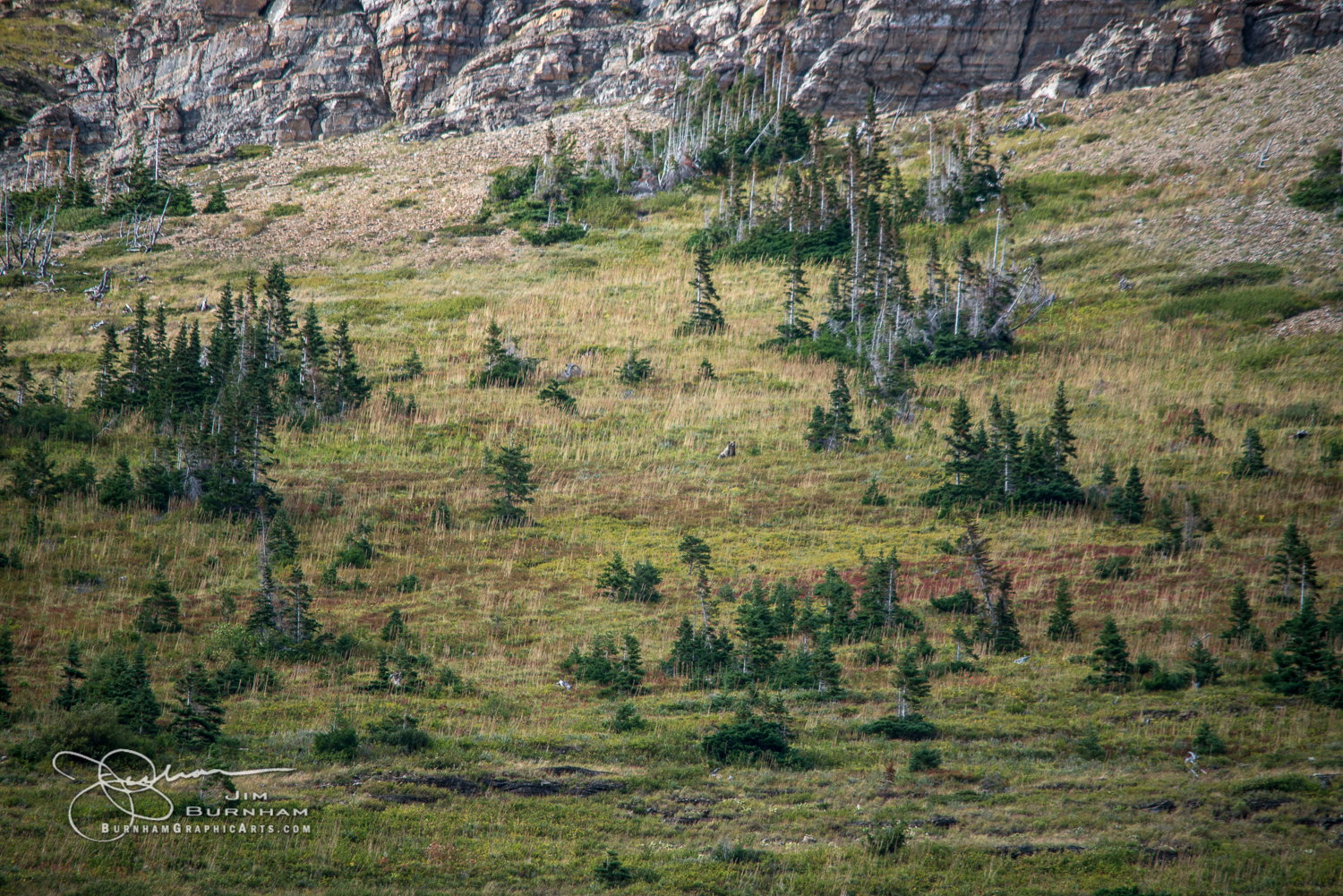
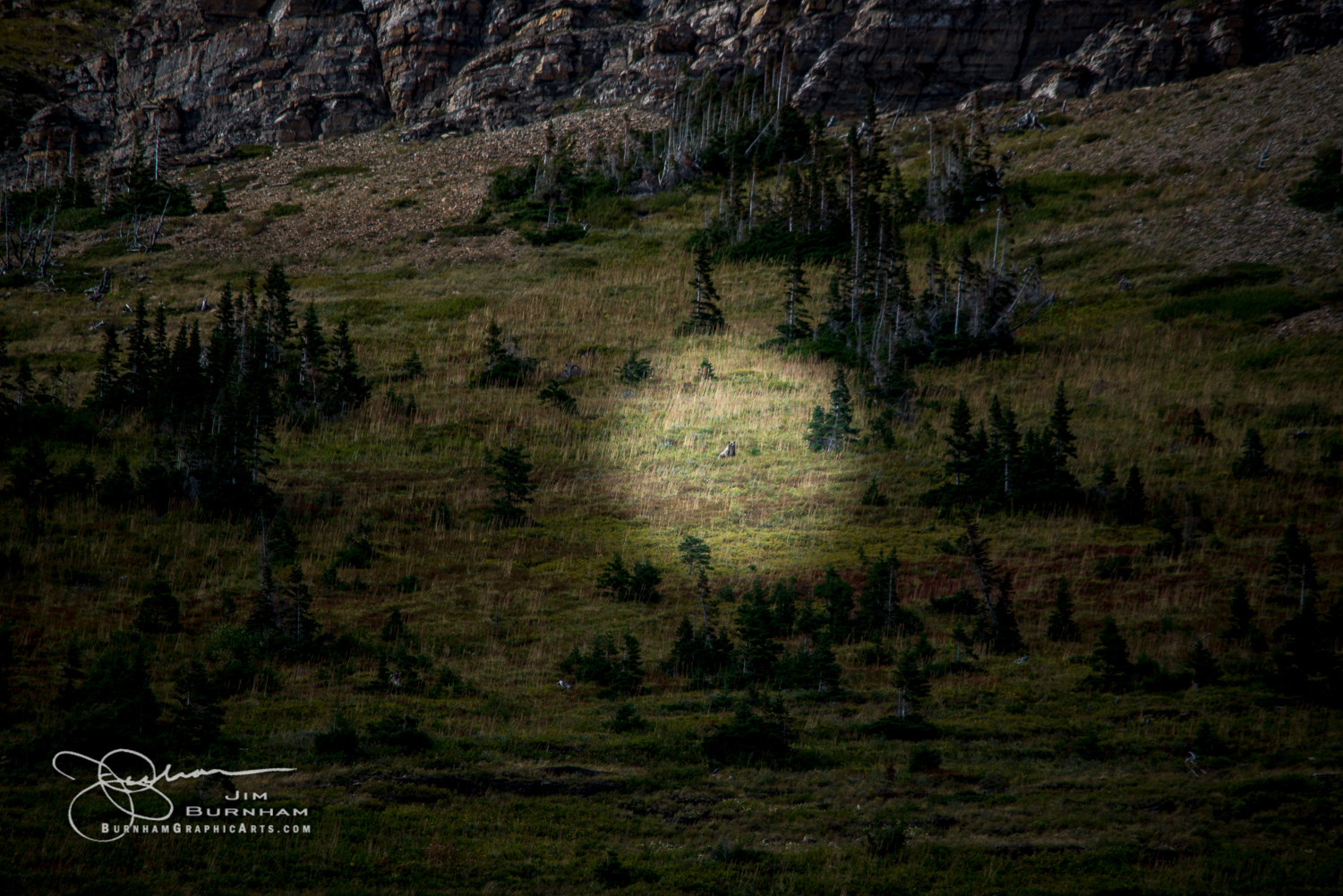

Back up at Logan Pass, were we ended our journey the day before from the opposite route, my hat was blown a good 50ft in the air by the strong winds blowing up the mountainside over the viewing platform. I thought it was gone for good, but it was rescued by the tall pines along the path.
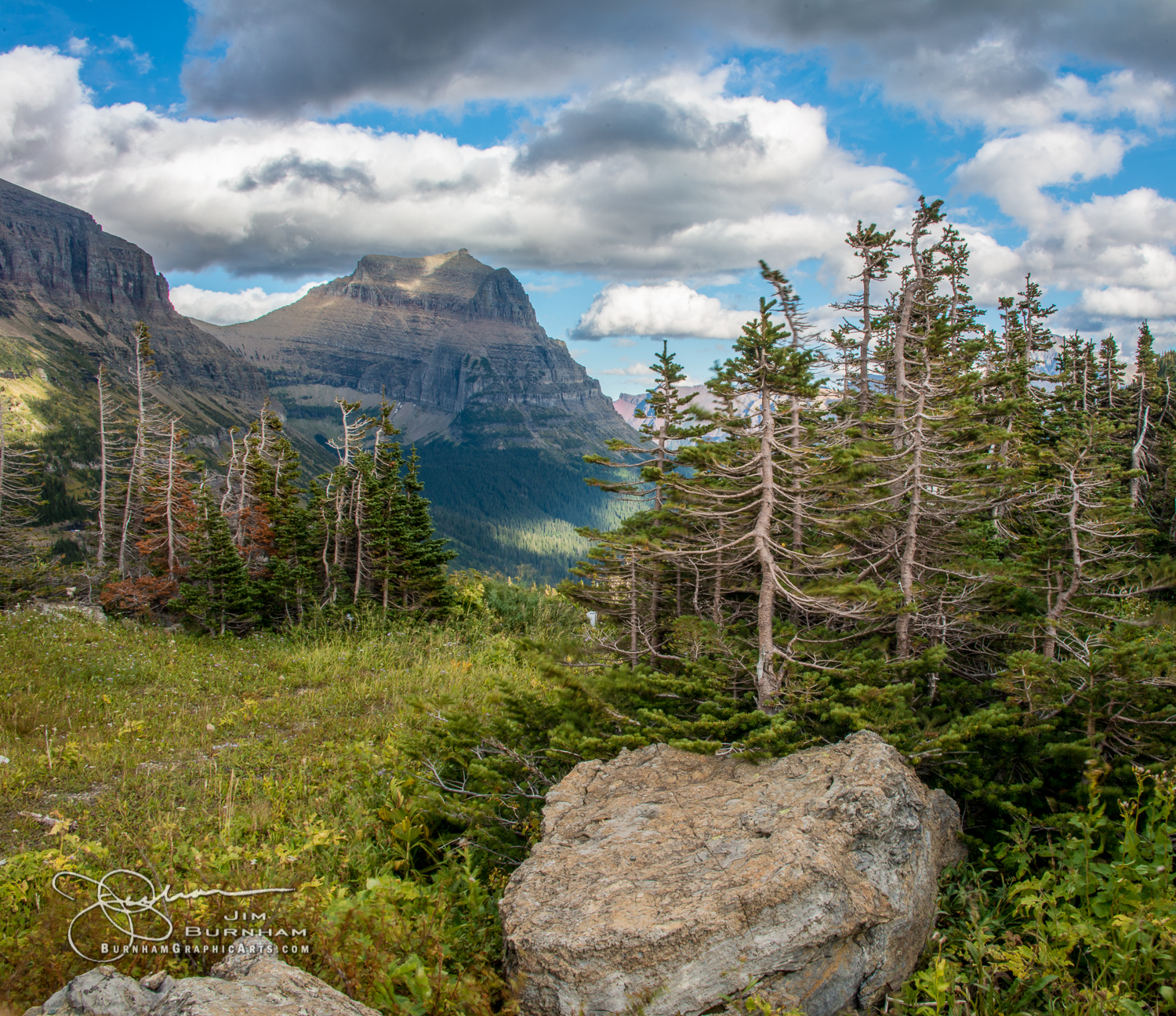
View of Whitebark Pine from Logan Pass Visitors Center looking East
| Read this account of a 300 mile journey to and through Glacier National Park on horseback in 1916 written by Mary Roberts Rinehart: http://www.digital.library.upenn.edu/women/rinehart/park/park.html |
Hungry Horse Reservoir
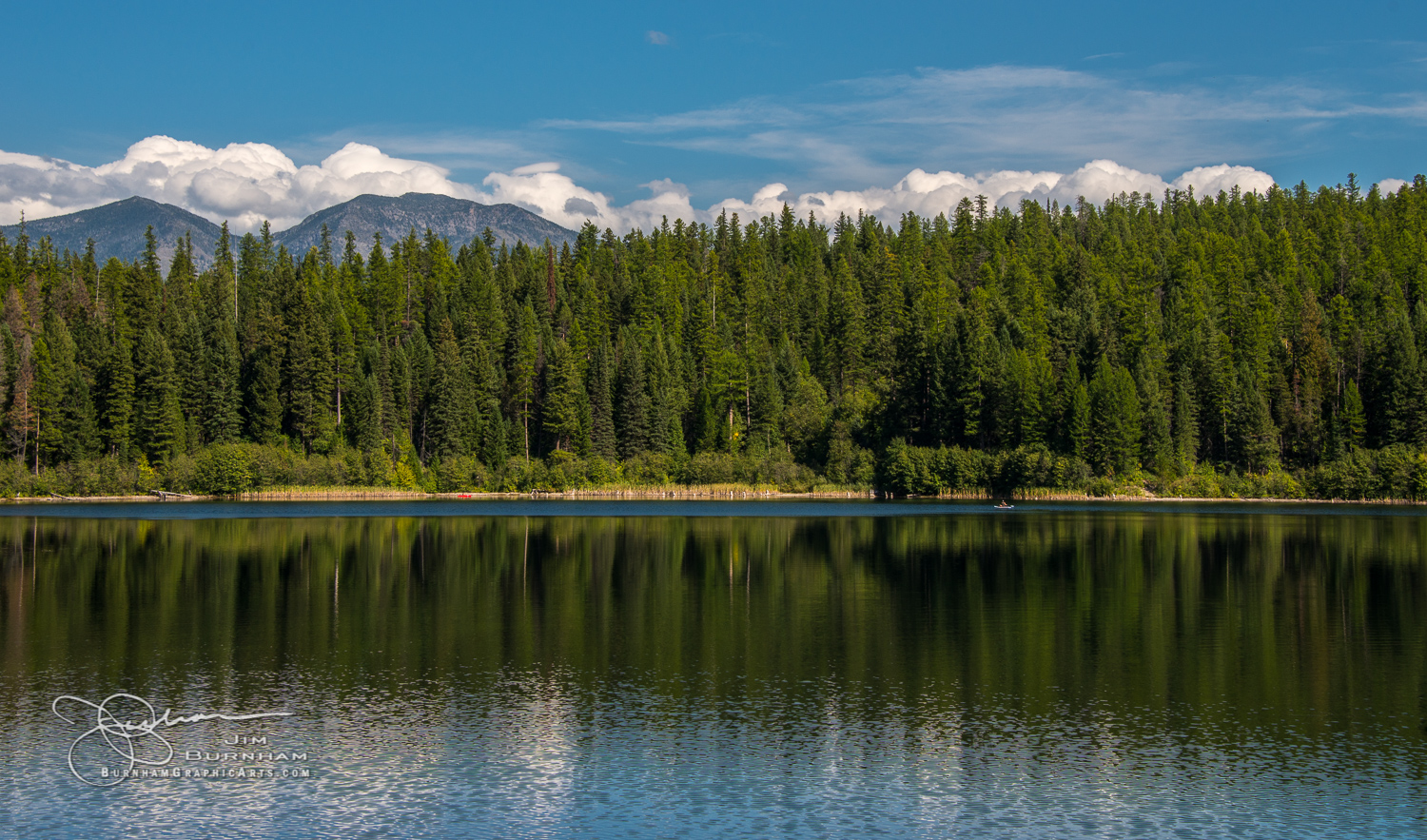
The dam at Hungry Horse Reservoir is the widest morning glory dam in the world (the unique feature is the round spillways, appropriately called “glory holes”). You wouldn’t figure that when you visit, but at 2,115 ft it is almost twice as wide (if not quite as tall) as Hoover Dam, which gets far more love. And, unlike Hoover, you can still drive across it and around the reservoir (if you have time to drive 120 miles!).
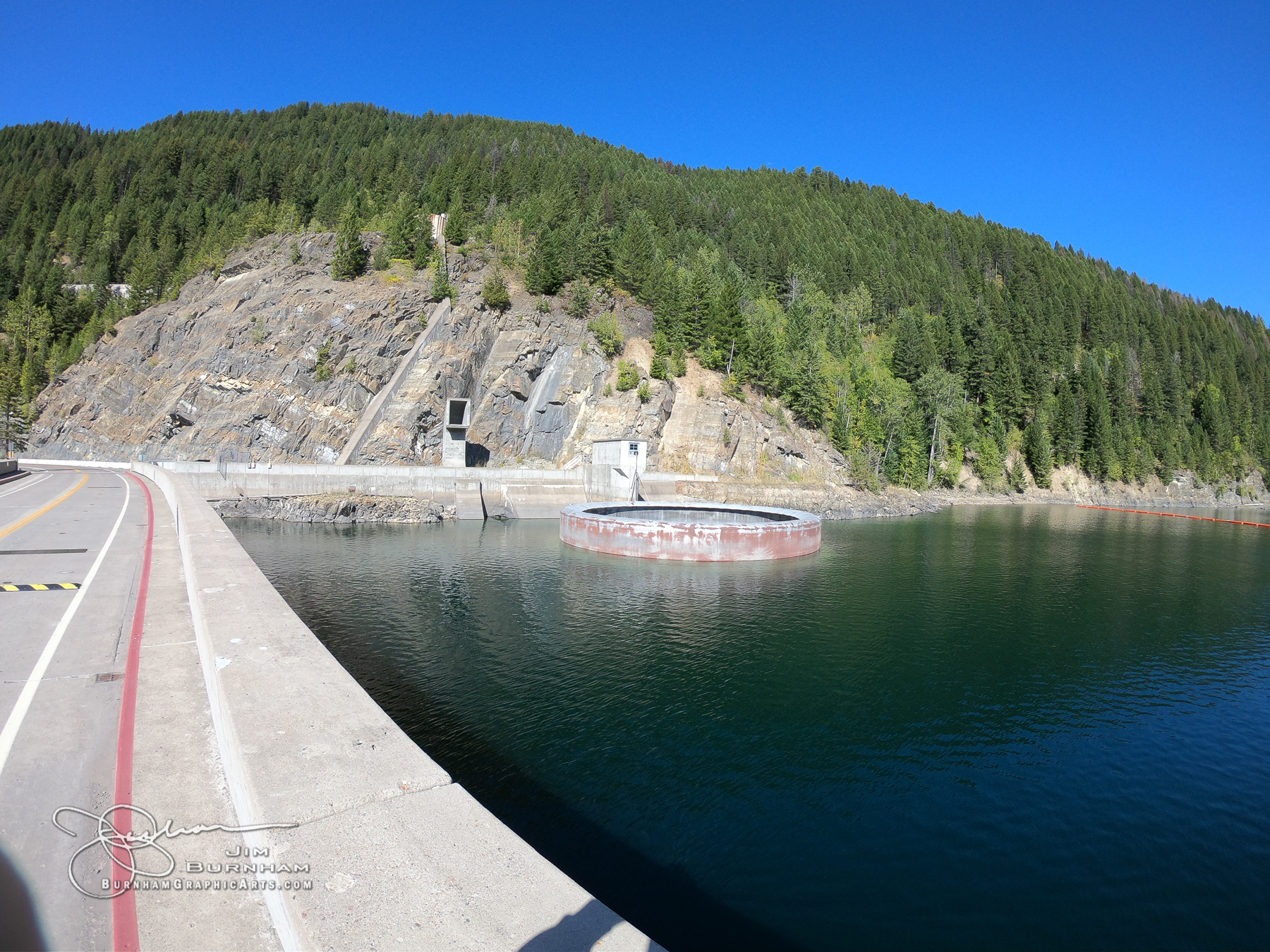
The reservoir is in the Flathead National Forest and is free to visit and drive through. There are paved and two-track roads that spider out from the main road leading to different campgrounds and creeks. It would be possible to spend a couple of days just driving around this one reservoir, but I suspect it would take me a couple more based on my habit of walking up streams where there is no trail.
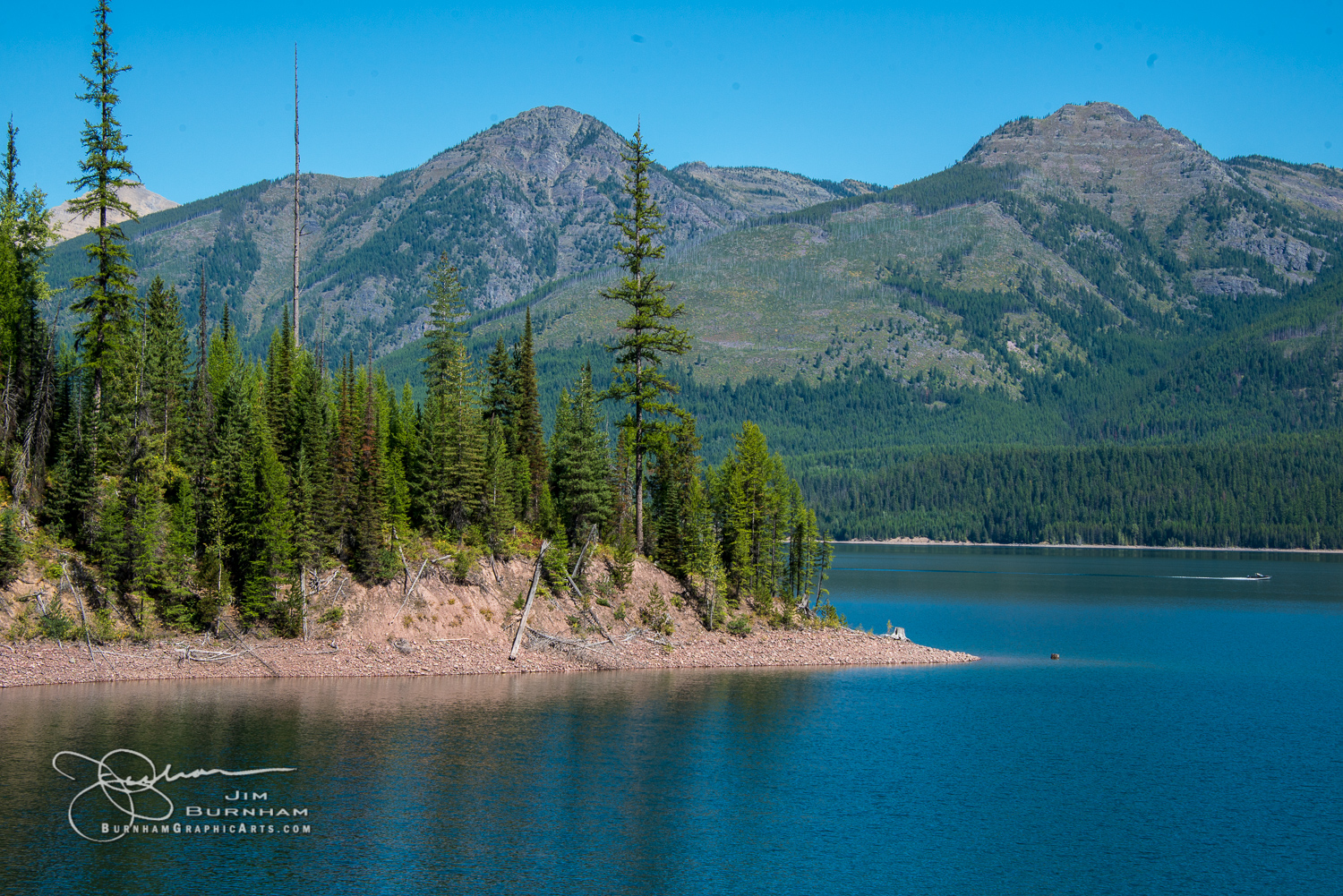
Along the way, there were several Osprey nesting sites precariously balanced at the very tops of dead trees. But, sadly no Ospreys. We were told they may have headed South.
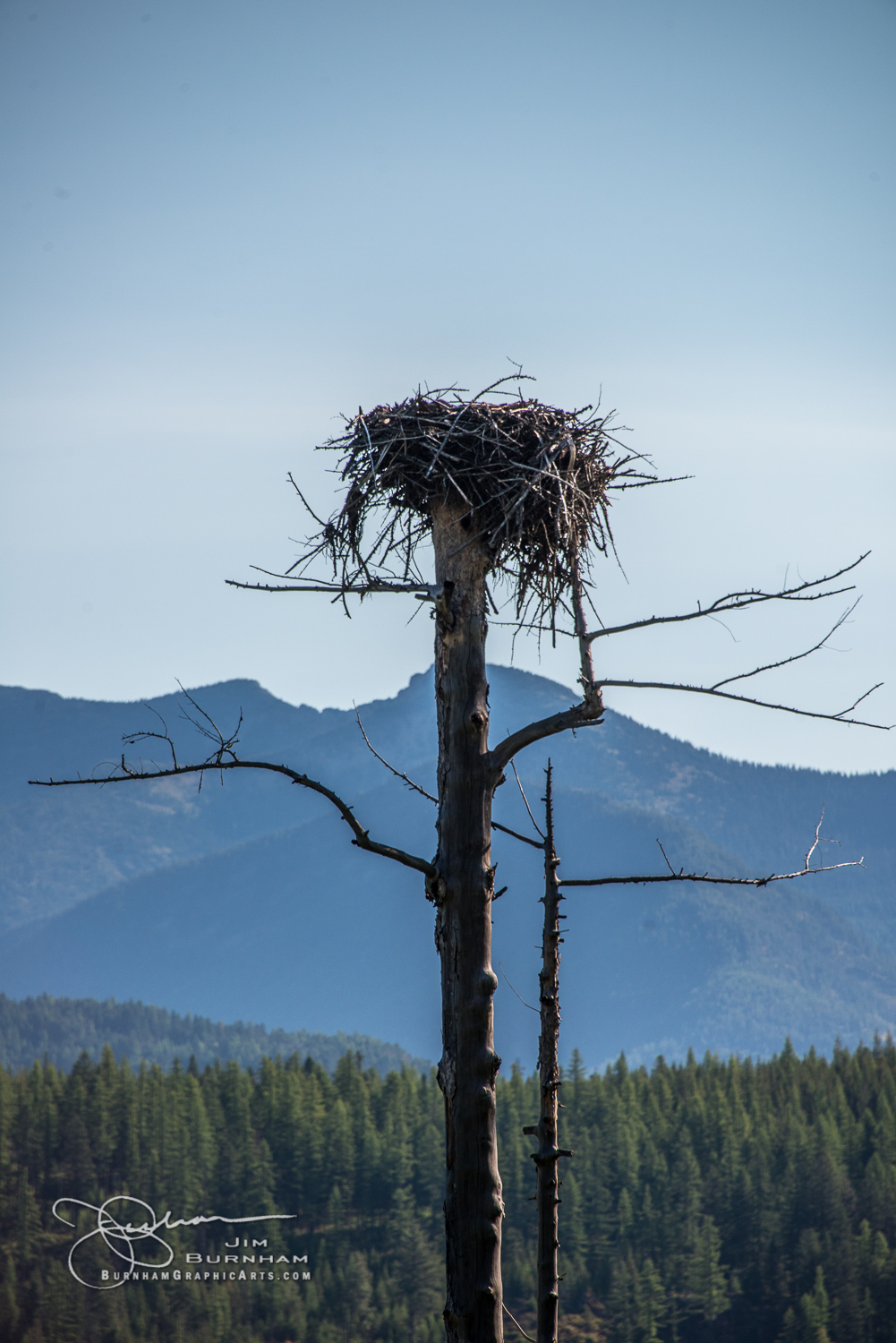
The opportunity to take flowing stream photos was abundant. There are numerous mountain streams feeding the reservoir from all around the perimeter of the forest. What you need for a decent stream shot is NO SUN. I thought this wouldn’t be a problem based on the weather over the last few days, but the current day was clear blue sky resulting in dappled sunlight down into the creek areas. Not exactly conducive to longer exposures and silky smooth water. But, we did find a small swarm of butterflies resting on the coals of an old campfire.
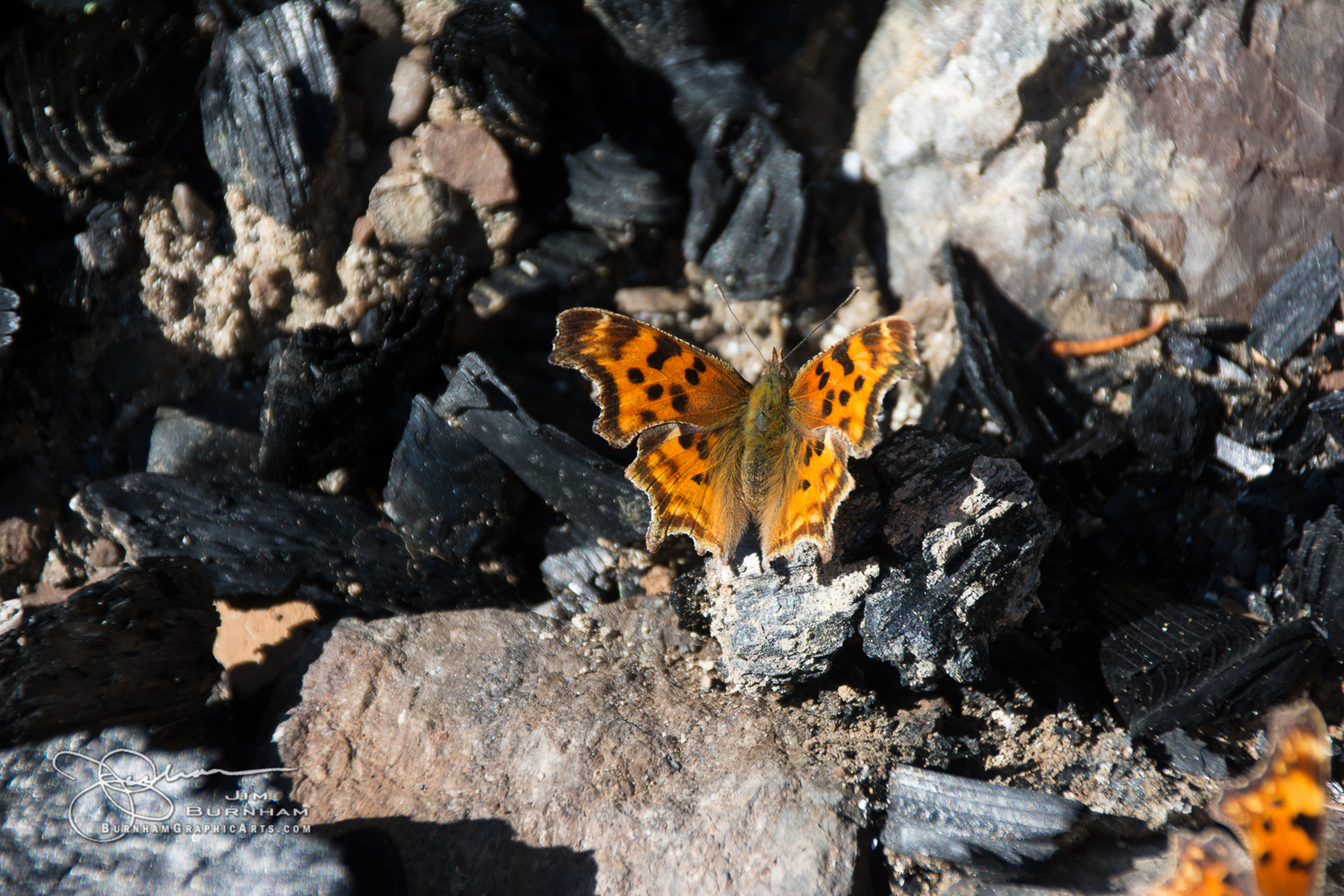
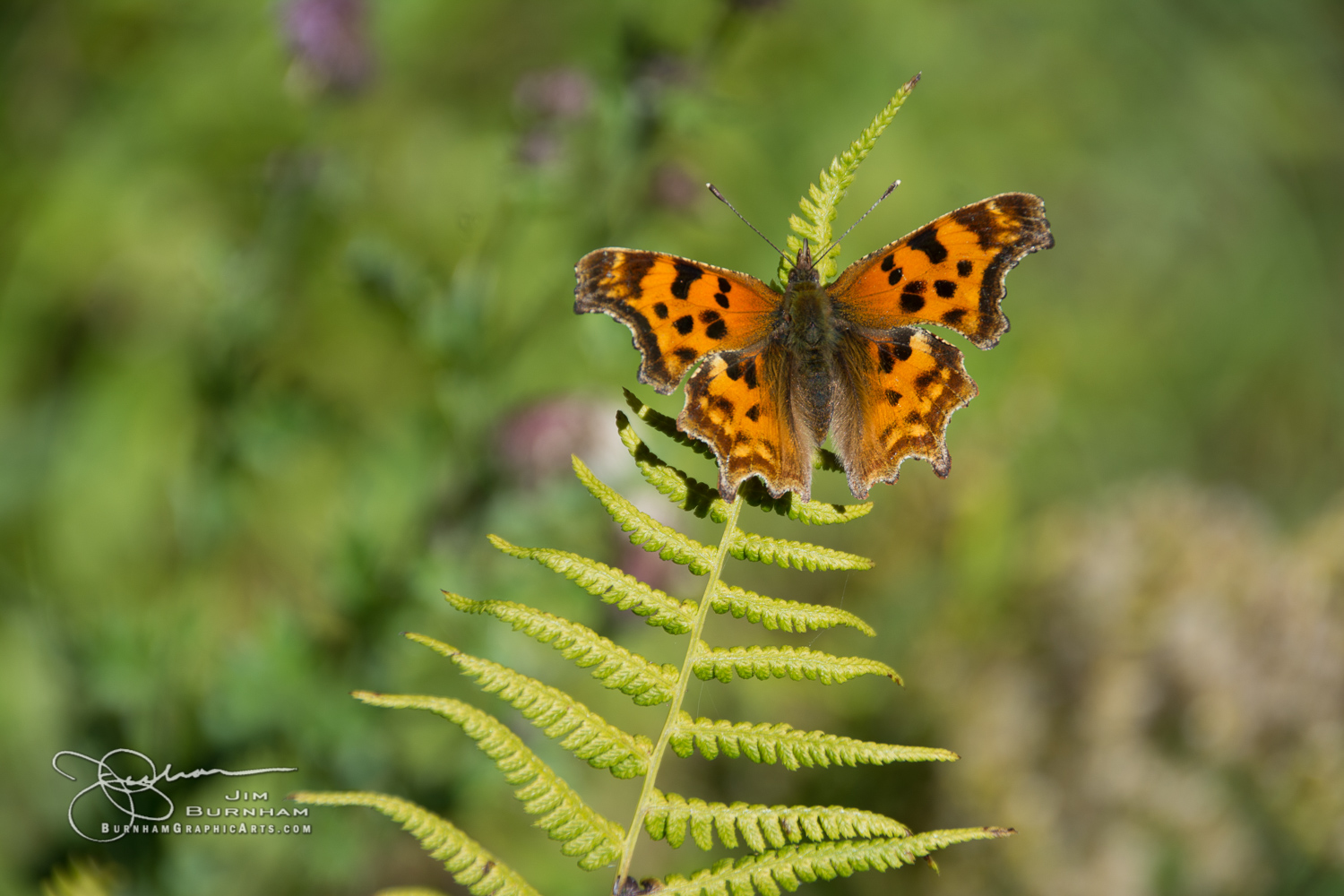
One wanted to meet Jim up close and personal!
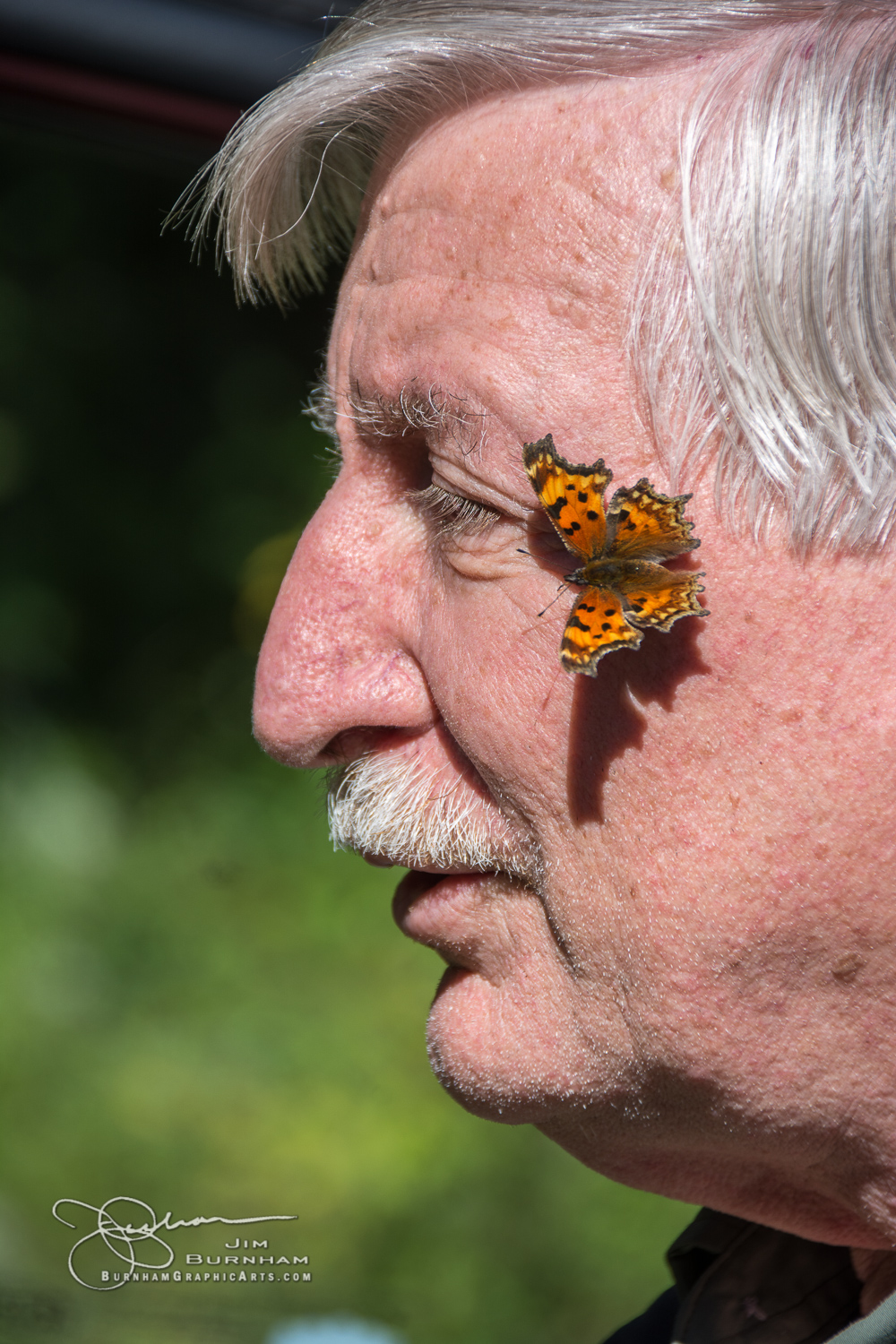
On my last morning, we headed up the north side of the reservoir.

We caught the day-old full moon rising over the forest.
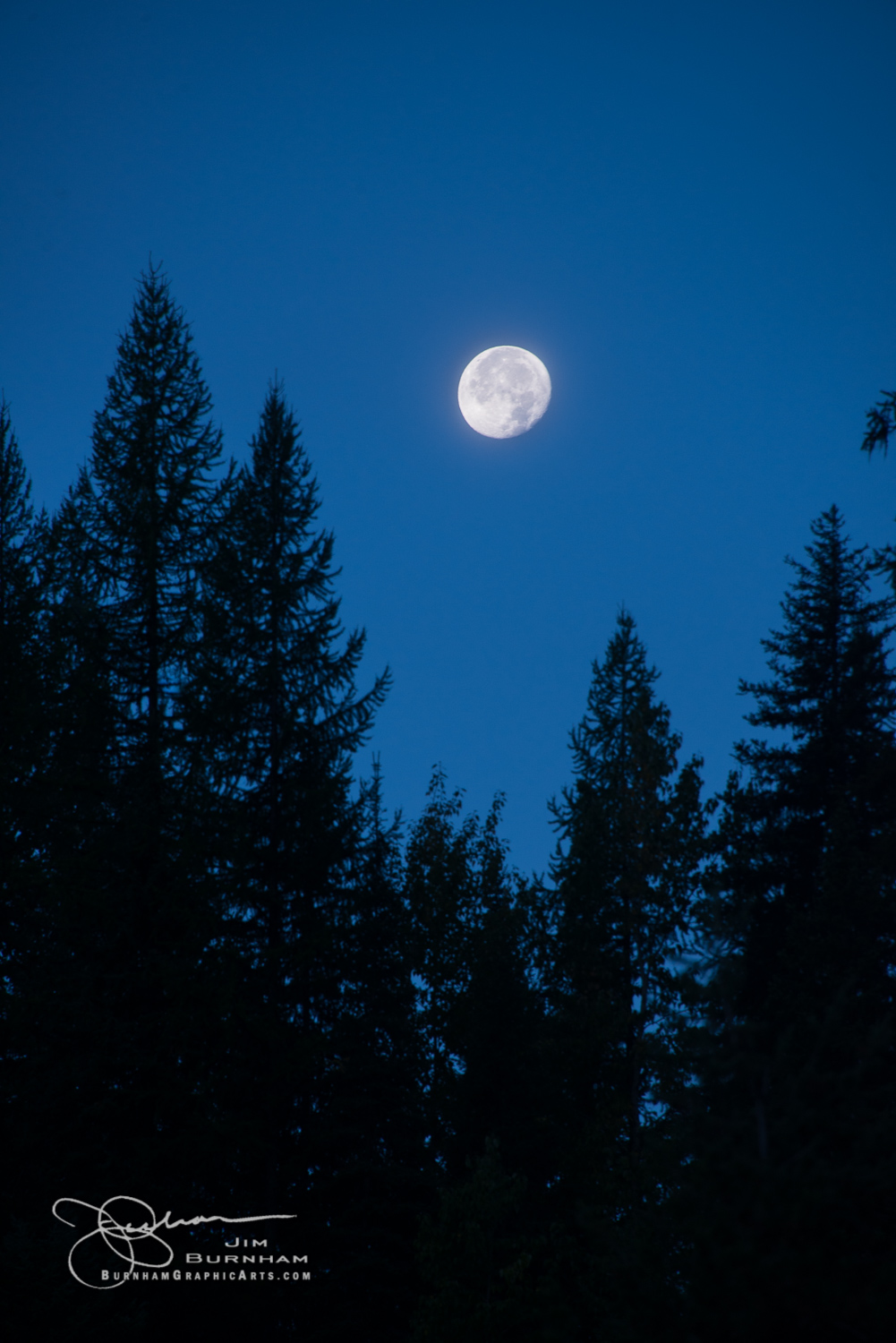
The map showed a long dirt road leading up to a fire tower. I couldn’t ignore THAT!
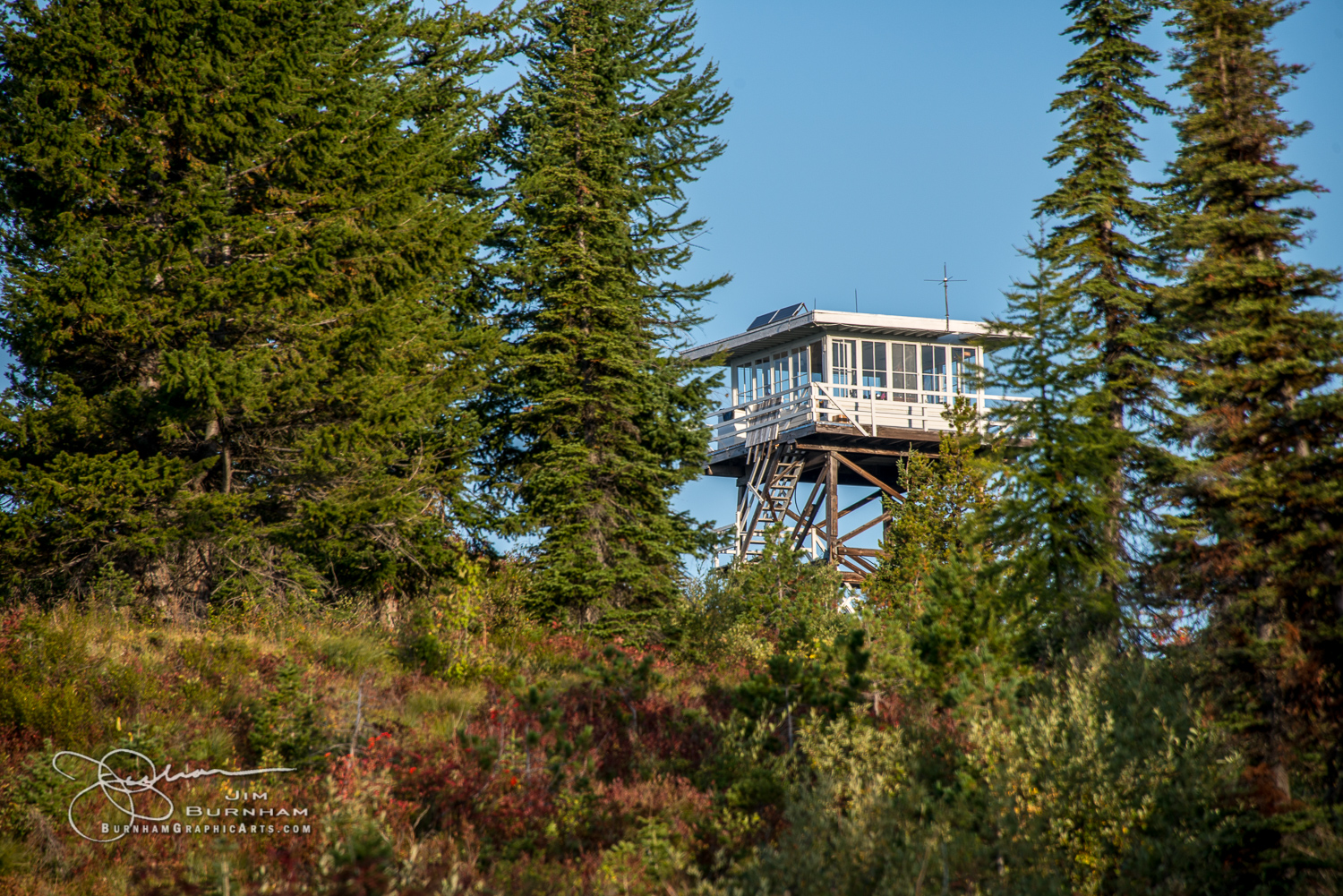
Hearing the barks of a dog, we assumed that the fire watcher was on duty, so we went up to meet him. The dog explained the animal tracks in the mud leading up to the tower, so we knew we weren’t stumbling on a Mountain Lion.
He invited us up and explained he was there for one last day waiting for the forest service to come and help him close up the tower for the season. Bonus!

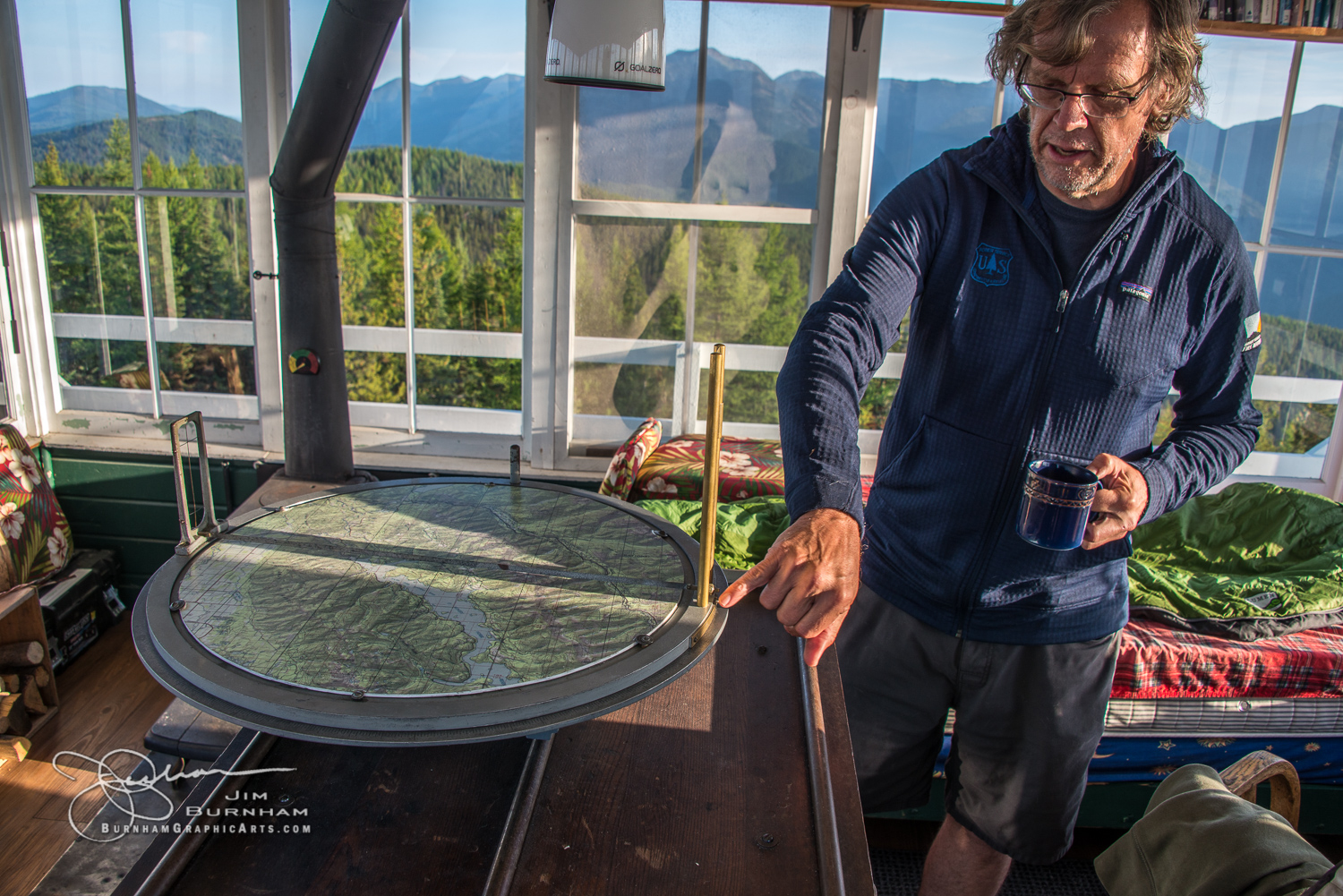
He also explained how they triangulate locations of fires in the surrounding forest using a round rotating map with a 360-degree view. Aligning the sight with the smoke and overlapping the data from a second tower will pinpoint fire locations exactly so they can be handled quickly.
Lastly (but actually second to last day), there’s Polebridge. What can we say about Polebridge on the NorthWest corner of the park, 16 miles from the Canadian border? Well, you might meet people like this guy. I was taking the second shot when he pulled up in his custom Porche/VW/Dune buggy and said “Hey, are you interested in taking a photo of some local wildlife?” At first, I didn’t know he was talking about himself, but he was. We had a good chat and got the history of the car and his dog merlin.

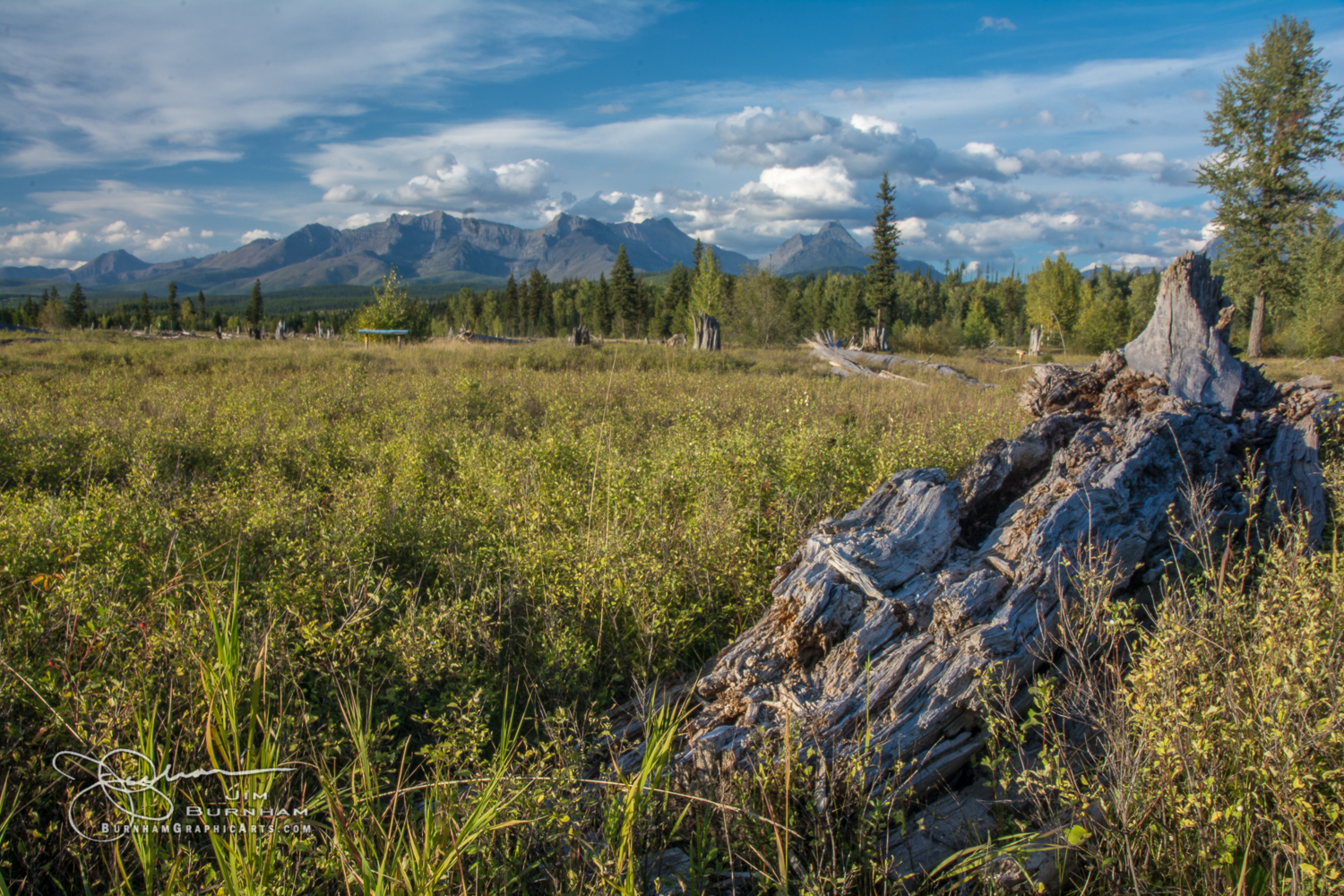

Again, another very loose and minimally planned photo adventure is in the books. Great time with my Black Hills Photo Shootout friends, Carolyn and Jim Caldwell, Mike Wolforth, and MJ Adelman. I hope you enjoyed this photo adventure. If you did, leave a comment below and please share. If you are interested in photography workshops and adventures, look up Jim Caldwell at: https://fotobug.podbean.com/ and MJ Adelman at http://emsphotoadventures.com/
 “I only went out for a walk and finally concluded to stay out till sundown, for going out, I found, was really going in.”
“I only went out for a walk and finally concluded to stay out till sundown, for going out, I found, was really going in.”
— John Muir
You can see some of these photos and more on my Instagram account @burnhamarts
What did I learn?
- Middle of September, I thought I underdressed for Northern Montana, it turns out I didn’t.
- Some animals I will never, ever, see up close in the wild (Excluding ex-Canadian Railroad engineers in modified PorcheVWs. I will accept that (until I don’t).
- I eat more on a trip when I’m with other people. If I’m alone, I tend to starve myself.
- Worried that your rental car will not make it up that unknown winding two-track dirt road? It probably won’t, but trust me when I say it will!
Thanks for reading. If you made it this far, congratulations! Please like and share or comment and share or pass it on and share using the social links below. If you would like an email when new posts are added, add your email below. Follow me on Instagram or Twitter: @BurnhamArts


I always say that ‘in my next life I want to be a world famous (or even UNfamous) great photographer”. Your experiences confirm that. I enjoyed my vicarious ‘trip’ with you. Thanks so much.
Thanks for providing me with an enjoyable “armchair” trip. (I grew up in the Rocky Mountain west). The images were wonderful. I also enjoyed the “asides” on cameras, lenses, exposure times, etc.
Another fantastic trip made even better by the people I was with!